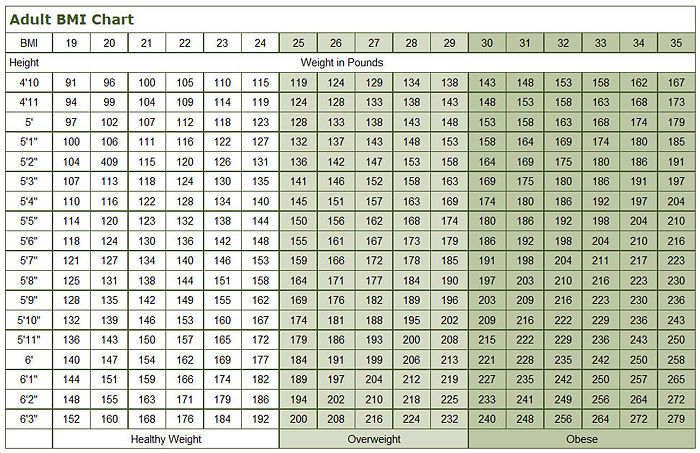Body mass index: Difference between revisions
imported>Anthony.Sebastian (→Limitations and alternatives: slight elaboration) |
imported>Anthony.Sebastian (Add BMI chart for adults) |
||
| Line 7: | Line 7: | ||
A BMI over 25 or less than 22.5 is associated with increased mortality.<ref name="pmid19299006">{{cite journal |author=Whitlock G, Lewington S, Sherliker P, ''et al'' |title=Body-mass index and cause-specific mortality in 900 000 adults: collaborative analyses of 57 prospective studies |journal=Lancet |volume=373 |issue=9669 |pages=1083–96 |year=2009 |month=March |pmid=19299006 |doi=10.1016/S0140-6736(09)60318-4 |url=http://linkinghub.elsevier.com/retrieve/pii/S0140-6736(09)60318-4 |issn=}}</ref> | A BMI over 25 or less than 22.5 is associated with increased mortality.<ref name="pmid19299006">{{cite journal |author=Whitlock G, Lewington S, Sherliker P, ''et al'' |title=Body-mass index and cause-specific mortality in 900 000 adults: collaborative analyses of 57 prospective studies |journal=Lancet |volume=373 |issue=9669 |pages=1083–96 |year=2009 |month=March |pmid=19299006 |doi=10.1016/S0140-6736(09)60318-4 |url=http://linkinghub.elsevier.com/retrieve/pii/S0140-6736(09)60318-4 |issn=}}</ref> | ||
==BMI chart for adults== | |||
{{Image|Adult-BMI-chart.jpg|center|700px|Find your BMI.}} | |||
==Limitations and alternatives== | ==Limitations and alternatives== | ||
Revision as of 21:56, 12 September 2009
Body mass index (abbreviated BMI) is a rough measure of proportionality between a person's height and weight, and is used to estimate whether a person is at a healthy weight for their height. BMI is calculated as weight in kilograms divided by height in meters squared. For english units, a conversion factor is applied.
.
Healthy BMI is between 18.5 and 24.9. Less than 18.5 is considered underweight; between 25 and 29.9 is considered overweight, over 30 is considered obese, and over 45 is considered morbidly obese.
A BMI over 25 or less than 22.5 is associated with increased mortality.[1]
BMI chart for adults

Find your BMI.
Limitations and alternatives
The BMI may overestimate percentage of body fat in athletes and others who have a muscular build, and may underestimate percentage of body fat in older persons and others who have lost muscle mass.[2]
Another limitation is in the choice of exponent. If humans scaled proportionally in all three dimensions as they become taller, the appropriate exponent would be 3, instead of the 2 used for BMI calculation. However, 2 is too low. Data from the United States indicates that an exponent of 2.6 is most appropriate.[3] Relatedly, the government of Singapore has set different cutoff levels of BMI, based on the shorter average stature and somewhat different body shape of Southeast Asians as compared to Europeans.[4]
An alternative anthropometric measure is the waist-to-hip ratio.
Notes
- ↑ Whitlock G, Lewington S, Sherliker P, et al (March 2009). "Body-mass index and cause-specific mortality in 900 000 adults: collaborative analyses of 57 prospective studies". Lancet 373 (9669): 1083–96. DOI:10.1016/S0140-6736(09)60318-4. PMID 19299006. Research Blogging.
- ↑ http://www.nhlbi.nih.gov/health/public/heart/obesity/lose_wt/risk.htm#limitations
- ↑ Nick Korevaar (July 2003). Notes on Body Mass Index and actual national data (PDF). University of Utah Math Department.
- ↑ Revision of Body Mass Index (BMI) Cut-offs in Singapore. Health Promotion Board (2005-03-16).
